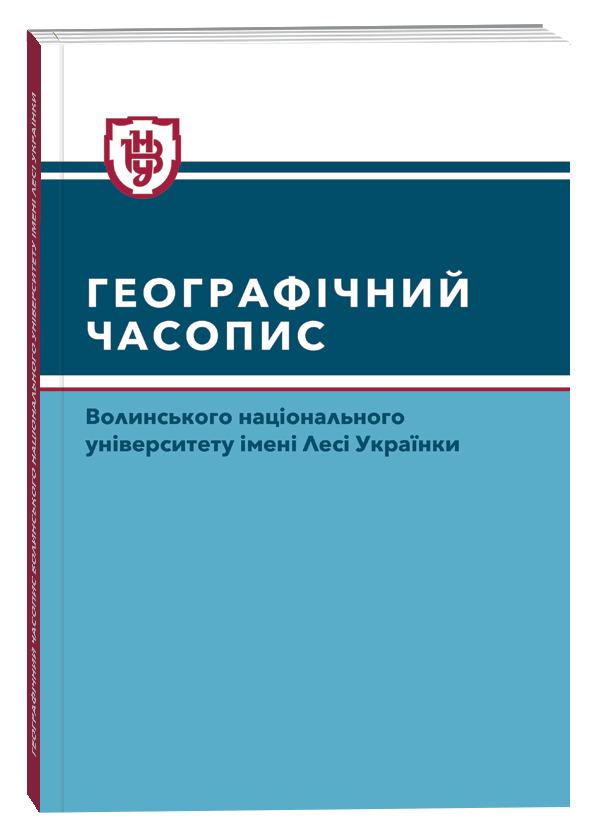THE REMOTE MONITORING OF CHANGES IN LAND USE WITHIN THE BOUNDARIES OF THE STOKHID RIVER CATCHMENT
DOI:
https://doi.org/10.32782/geochasvnu.2024.4.15Keywords:
geoinformation systems, remote sensing of the Earth, Google Earth Engine, QGIS, land cover, catchment basin, Stokhid riverAbstract
The article examines the changes in wetland landscapes within the Stokhid River basin in Volyn and their impact on the region’s sustainable development and ecological balance, using GIS and remote sensing data. Geospatial data was used to analyze the structure and distribution of landscapes for accurate area mapping. Environmental aspects are highlighted, and optimal strategies for natural resource conservation and management are identified. GIS enabled the investigation of wetland landscape changes and the development of methods for controlling and sustainably using the land. Supervised classification was performed using the Earth Engine service, where the SmileCART classifier demonstrated the highest accuracy (99,50%). The identification and detailed analysis of statistical data on land cover changes in the Stokhid River basin is a key step in studying the impact of human activity on the natural ecosystems of this region. The research findings can serve as a basis for developing strategies for sustainable land use and implementing effective environmental protection measures, particularly for the preservation of forested areas in the studied location.
References
Загальна гідрологія / за ред. В.К. Хільчевського і О.Г. Ободовського : підручник. 2-ге вид., доповнене. Київ : ВПЦ «Київ. університет», 2008. 399 с.
Паньків З.П. Земельні ресурси : навч. посіб. Львів : Вид. центр ЛНУ ім. Івана Франка, 2008. 272 с.
Перелік угідь згідно з Класифікацією видів земельних угідь (КВЗУ). URL: https://shels.com. ua/document.htm?doc=471 (дата звернення: 10.09.2024).
Стохід (річка). Вікіпедія. URL: https://uk.wikipedia.org/w/index.php?title=%D0%A1%D1%82% D0%BE%D1%85%D1%96%D0%B4&oldid=41599826 (дата звернення: 10.09.2024).
Armenteras D., Rodríguez N., Sua S., Romero M. Patterns and causes of deforestation in the Colombian Amazon. Ecological Indicators. 2005. Vol. 6. Іs. 2. P. 353‒368. DOI: https://doi.org/10.1016/j.ecolind.2005.03.014.
Begum S., Ophra, S.J., Hossain A., Ferdous M.T., Rafid F.A. (2024). Land Cover Change using GIS and RS Techniques of the Padma River Floodplain in the Three Adjacent Districts in Bangladesh. Jagannath University Journal of Science. 2024. Vol. 10. Is. 1. P. 43–54. DOI: https://doi.org/10.3329/jnujsci.v10i1.71249.
Bradshaw J., Hoelscher P., Richardson D. An Index of Child Well-Being in the European Union. Social Indicators Research. 2007. Vol. 80. Is. 1. P. 133–177. DOI: https://doi.org/10.1007/s11205-006-9024-z.
Burmeister C., Schanze J. Retrospective Analysis of Systematic Land-Cover Change in the Upper Western Bug River Catchment, Ukraine. ACC Journal. 2016. Vol. 22. Is. 1. P. 7–18. DOI: https://doi.org/10.15240/tul/004/2016-1-001.
Debnath J., Das (Pan) N., Ahmed I., Bhowmik M. Channel migration and its impact on land use/land cover using RS and GIS: A study on Khowai River of Tripura, North-East India. The Egyptian Journal of Remote Sensing and Space Science. 2017. Vol. 20. Is. 2. P. 197–210. DOI: https://doi.org/10.1016/j.ejrs.2017.01.009.
Dwivedi R.S., Sreenivas K., Ramana K.V. Cover: Land‐use/land‐cover change analysis in part of Ethiopia using Landsat Thematic Mapper data. International Journal of Remote Sensing. 2005. Vol. 26. Is. 7. P. 1285–1287. DOI: https://doi.org/10.1080/01431160512331337763.
Ee.Classifier.confusionMatrix. Google Earth Engine. Google for Developers. URL: https://developers.google.com/earth-engine/apidocs/ee-classifier-confusionmatrix (дата звернення: 10.09.2024).
Fan F., Weng Q., Wang Y. Land Use and Land Cover Change in Guangzhou, China, from 1998 to 2003, Based on Landsat TM /ETM+ Imagery. Sensors. 2007. Vol. 7. Is. 7. P. 1323–1342. DOI: https://doi.org/10.3390/s7071323.
Geist H.J., Lambin E.F. Proximate Causes and Underlying Driving Forces of Tropical Deforestation. BioScience. 2002. Vol. 52. No 2. P. 143–150. DOI: ttps://doi.org/10.1641/0006-3568(2002)052[0143:PCAUDF]2.0.CO;2.
Geist H., McConnell W., Lambin E.F., Moran E., Alves D., Rude, T. Causes and Trajectories of Land-Use/Cover Change. В E.F. Lambin, H. Geist (еd.), Land-Use and Land-Cover Change. Springer Berlin Heidelberg. P. 41–70. DOI: https://doi.org/10.1007/3-540-32202-7_3.
Google Earth Engine. URL: https://earthengine.google.com (дата звернення: 10.09.2024).
Gordon A.D., Breiman L., Friedman J.H., Olshen R.A., Stone, C.J. Classification and Regression Trees. Biometrics. 1984. Vol. 40. No 3, P. 874. DOI: https://doi.org/10.2307/2530946.
Griffiths P. Utilizing the depth of the Landsat archive to reconstruct recent land change in the Carpathian ecoregion: doctoral Thesis, Humboldt-Universität zu Berlin, Mathematisch-Naturwissenschaftliche Fakultät II, 2013. DOI: https://doi.org/10.18452/16827.
Krasovskyi H.Ya., Shumeiko V.O., Klochko T.O., Sementsova N.I. Information technologies for monitoring the environmental consequences of amber production in Ukraine. Ecological Safety and Balanced Use of Resources. 2018. Vol. 2. Is. 18. P. 107–117. DOI: https://doi.org/10.31471/2415-3184-2018-2(18)-107-117.
Lambin E.F., Geist, H. (еd.). Land-Use and Land-Cover Change: Local Processes and Global Impacts. Springer, 2006. DOI: https://doi.org/10.1007/3-540-32202-7.
Lambin E.F., Turner B.L., Geist H.J., Agbola S.B., Angelsen A., Bruce J.W., Coomes O.T., Dirzo R., Fischer G., Folke C., George P.S., Homewood K., Imbernon J., Leemans R., Li X., Moran E.F., Mortimore M., Ramakrishnan P.S., Richards J.F., … Xu J. The causes of land-use and land-cover change: Moving beyond the myths. Global Environmental Change. 2001. Vol. 11. Is. 4, P. 261–269. DOI: https://doi.org/10.1016/S0959-3780(01)00007-3.
Manandhar R., Odeh I., Ancev T. Improving the Accuracy of Land Use and Land Cover Classification of Landsat Data Using Post-Classification Enhancement. Remote Sensing, 2009. Vol. 1 (3). P. 330–344. DOI: https://doi.org/10.3390/rs1030330.
Manandhar R., Odeh I.O.A., Pontius R.G. Analysis of twenty years of categorical land transitions in the Lower Hunter of New South Wales, Australia. Agriculture, Ecosystems & Environment, 2010. Vol. 135. Is. 4. P. 336–346. DOI: https://doi.org/10.1016/j.agee.2009.10.016.
Mahmood R., Pielke Sr.R., Loveland T., Mcalpine C. Climate Relevant Land Use and Land Cover Change Policies. Bulletin of the American Meteorological Society. 2015. Vol. 97. Is. 2. P. 195–202. DOI: https://doi.org/10.1175/BAMS-D-14-00221.1.
McLachlan J.G. Discriminant analysis and statistical pattern recognition. New York : John Wiley, 1992. 526 p. DOI: https://doi.org/10.1002/0471725293.
Nations F. and A. O. of the U., & Programme, U. N. E. The Future of Our Land: Facing the Challenge. URL: https://wedocs.unep.org/xmlui/handle/20.500.11822/32745 (дата звернення: 10.09.2024).
Pluntke T., Pavlik D., Bernhofer C. Reducing uncertainty in hydrological modelling in a data sparse region. Environmental Earth Sciences. 2014. Vol. 72. Is. 12. P. 4801–4816. DOI: https://doi.org/10.1007/s12665-014-3252-3.
Pontius R.G., Shusas E., McEachern M. Detecting important categorical land changes while accounting for persistence. Agriculture, Ecosystems & Environment. 2004. Vol. 101. Is. 2–3. P. 251–268. DOI: https://doi.org/10.1016/j.agee.2003.09.008.
Schanze J., Trümper J., Burmeister C., Pavlik D., Kruhlov I. A methodology for dealing with regional change in integrated water resources management. Environmental Earth Sciences. 2012. Vol. 65. Is. 5. P. 1405–1414. DOI: https://doi.org/10.1007/s12665-011-1311-6.
Seegert J., Berendonk T. U., Bernhofer C., Blumensaat F., Dombrowsky I., Fuehner C., Grundmann J., Hagemann N., Kalbacher T., Kopinke F.-D., Liedl R., Leidel M., Lorz C., Makeschin F., Markova D., Niemann S., Röstel G., Schanze J., Scheifhacken N., Krebs P. Integrated water resources management under different hydrological, climatic and socio-economic conditions: Results and lessons learned from a transdisciplinary IWRM project IWAS. Environmental Earth Sciences. 2014. Vol. 72. Is. 12. P. 4677–4687. DOI: https://doi.org/10.1007/s12665-014-3877-2.
Silva Leal R.S.L., Almeida N.V., Silva M.D.D. Impacts of changes in land cover and land use on the hydrological cycle of the Tapuio River sub-basin/AL. Journal of Hyperspectral Remote Sensing. 2023. Vol. 13. Is. 4. P. 497–511. DOI: https://doi.org/10.29150/jhrs.v13.4.p497-511.
Sleeter R., Sleeter B.M., Williams B., Hogan D., Hawbaker T., Zhu Z. A carbon balance model for the great dismal swamp ecosystem. Carbon Balance and Management. 2017. Vol. 12. No 2. DOI: https://doi.org/10.1186/s13021-017-0070-4.
Takada T., Miyamoto A., Hasegawa S.F. Derivation of a yearly transition probability matrix for land-use dynamics and its applications. Landscape Ecology. 2010. Vol. 25 Is. 4. P. 561–572. DOI: https://doi.org/10.1007/s10980-009-9433-x.
Turner M.G., Gardner R.H. Landscape Ecology in Theory and Practice: Pattern and Process. 2nd ed. Springer, 2015. 482 p. DOI: https://doi.org/10.1007/978-1-4939-2794-4.
Uhl A., Melnyk O., Melnyk Y., Manko P., Brunn A., Fesyuk V. Remote sensing monitoring of changes in forest cover in the Volyn region: A cross section for the first two decades of the 21st century. Visnyk of V. N. Karazin Kharkiv National University, Series “Geology. Geography. Ecology”. 2024. Vol. 60. P. 272–283. DOI: https://doi.org/10.26565/2410-7360-2024-60-19.
Winterbottom S.J. Medium and short-term channel planform changes on the Rivers Tay and Tummel, Scotland. Geomorphology. 2000. Vol. 34. Is. 3–4. P. 195–208. DOI: https://doi.org/10.1016/S0169-555X(00)00007-6.







